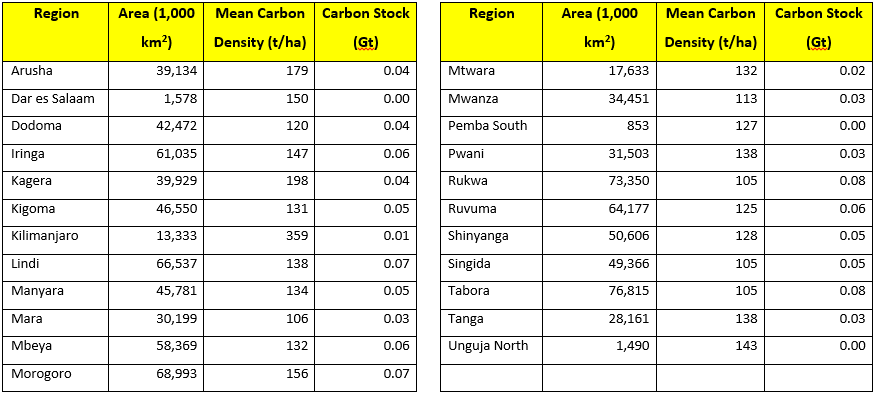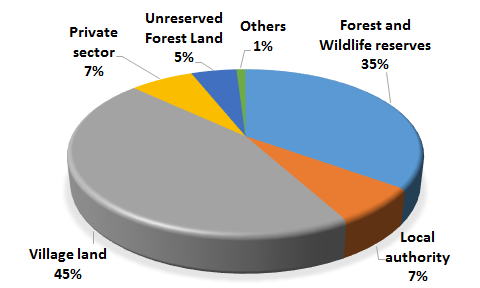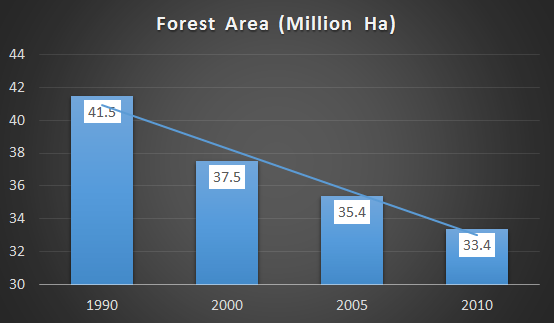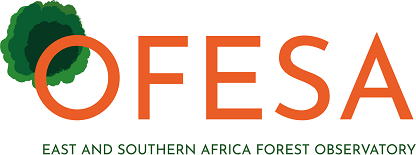Tanzania Forest Indicators
Carbon Density and Stock

Drivers of Deforestation and Degradation
Drivers of Deforestation and Degradation
Who is Monitoring
Monitored by Ministry of Agriculture, Ministry of Planning, Economy and Empowerment (Monitoring of National Strategy for Growth and Reduction of Poverty – NSGRP, also known as MKUKUTA)
How is it Monitored
- Crop productivity aggregated at four governance levels: village, district, regional and national
- Shifting arable land with changes in temperature and precipitation as detailed in the National Investment Centre (NIC) and NAPA documents
- Changes in cropping patterns (mono-crop vs. mixed) farming, timing (earlier or later), crop types, seed varietiesfertilizers, pesticides and herbicides
- Percentage change in food crop production Ministry of Agriculture and Food Security (MAFS)
- Percentage of smallholders using modern methods of farming (irrigation, fertilizers and improved seeds) National Bureau of Statistics (NBS)
- Percentage of households whose main income is derivfrom harvesting, processing and marketing of natural resources products National Bureau of Statistics (NBS) or Ministry of Natural Resources and
- Percentage of smallholders who have one or more off-farm income generating activities National Burea of Statistics
- Percentage of smallholders who accessed formal credits for agricultural purpose (NBS)
Who is Monitoring
Tanzania Forest Services and National Bureau of Statistics HBS/National Census
How is it Monitored
- Revenues from sale of forest products
- Information related to illegal activities and changes in forest utilization
- Percentage change in proportion of rural households reliance on forest products
- Adoption of alternative livelihood activities
Who is Monitoring
Ministry of Planning, Economy and Empowerment, Ministry of Energy and Tanzania Forest Service
How is it Monitored
- Percentage increase in number of customers connected to the national grid and off-grid sources of electricity Ministry of Energy and Minerals (MEM), National/Stations
- Percentage of households in rural and urban areas using alternative sources of energy to wood fuel (including charcoal) as their main source for cooking NBS
- Energy generation capacity by source (hydro, wind, solar, gas)
- Percentage of population connected to the national grid
- National energy generation capacity
- Number of projects/programs on alternative energy sources
- Proportion of households dependent on forests for energy resources
Who is Monitoring
Tanzania Forest Service
How is it Monitored
- Hectares of land under forest fire annually
Roads generally result in increased deforestation and degradation (Nepstad et al. 2001). They make the transport of goods possible and economically viable, linking resources and producers to markets at lower costs
A large proportion of the population depends on forests in some way for their livelihoods or for their fuelwood, this consequently puts pressure on forests and land
Source: Adapted from Excellensia Consulting (2010)
Ecosystem Types
Ecosystem Types
|
Ecosystem type |
Main regions |
|
Acacia savanna |
Shinyanga, Singida |
|
Coastal forest |
Lindi, Mtwara, Pwani |
|
Eastern Arc/montane forest |
Iringa, Morogoro, Tanga |
|
Guinea-Congo |
Kagera, Mwanza |
|
Miombo woodland |
Manyara, Morogoro, Tabora |
|
Miombo woodland |
Iringa, Morogoro, Tabora |
Estimated emissions
Estimated emissions

Forest Change Statistics
Forest Change Statistics
Forest change statistics (2002 – 2013) for Tanzania Mainland
|
No. |
Change class |
Area (x 1,000 ha) |
Annual loss (ha/yr) |
|
1 |
Forest |
32,000.9 |
|
|
2 |
Deforestation |
6,406.70 |
582,427.27 |
|
3 |
Non forest |
47,595.3 |
|
|
4 |
Wetland |
4,506.9 |
|
|
5 |
Water |
1,697.3 |
|
|
6 |
No data (clouds/shadow) |
304.9 |
|
Forest change statistics (2004 – 2012) for Zanzibar Island

Forest Cover Types
Forest Cover Types
|
Vegetation Type |
Eastern |
Southern |
S. Highlands |
Central |
Lake |
Western |
Northern |
|
Forest: Humid montane (ha) |
274,823 |
70,169 |
175,622 |
38,544 |
194,815 |
24,023 |
418,916 |
|
Forest: Lowland (ha) |
681,772 |
610,118 |
65,340 |
2,802 |
16,924 |
240,331 |
91,141 |
|
Forest: Mangrove (ha) |
153,423 |
37,899 |
- |
132 |
- |
68 |
2,081 |
|
Forest: Plantation (ha) |
16,180 |
3,095 |
558,227 |
2,559 |
85,427 |
10,533 |
44,605 |
|
Woodland: Closed (> 40%) |
1,822,100 |
1,847,086 |
838,212 |
763,517 |
537,505 |
1,869,029 |
363,751 |
|
Woodland: Open (10-40%) |
5,045,878 |
8,140,873 |
8,707,824 |
2,945,331 |
2,843,421 |
4,896,585 |
3,517,603 |
|
Forest and woodland total |
7,994,176 |
10,709,239 |
10,345,226 |
3,752,886 |
3,678,091 |
7,040,570 |
4,438,097 |
Forest Ownership
Forest Ownership

People and Economy
People and Economy
(a) Employment
7,000 people are directly employed by the forestry sector, according to 2011 FAO data.
(b) Economic Value
The forestry sector contributed USD 612.9 million to the economy in 2011, which is approximately 2.7% of the GDP.
Total Forest Cover
Total Forest Cover
Trends in forest change from 1990 to 2010 showing an average loss of 403,328 ha per year

Total Forested Land
Total Forested Land
Forests include
- Montane
- Lowland
- Mangrove
- Plantation Forest
Woodland include
- Open and Closed Woodlands
- Thickets
Woodlands occupy 93% of total forested land
Quick Links
- National Strategies
- National Forest Reports
- Publications
- National Focal Points
- Laws and Policies
- Site Map
- Sign in / Sign Out





